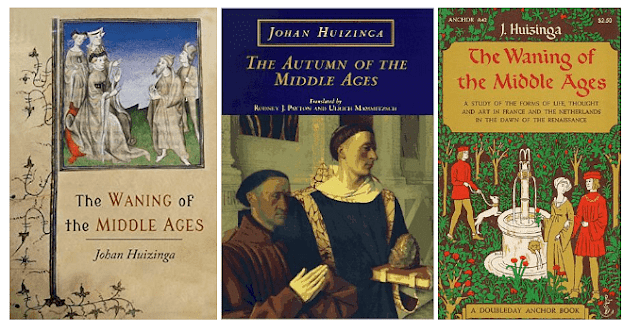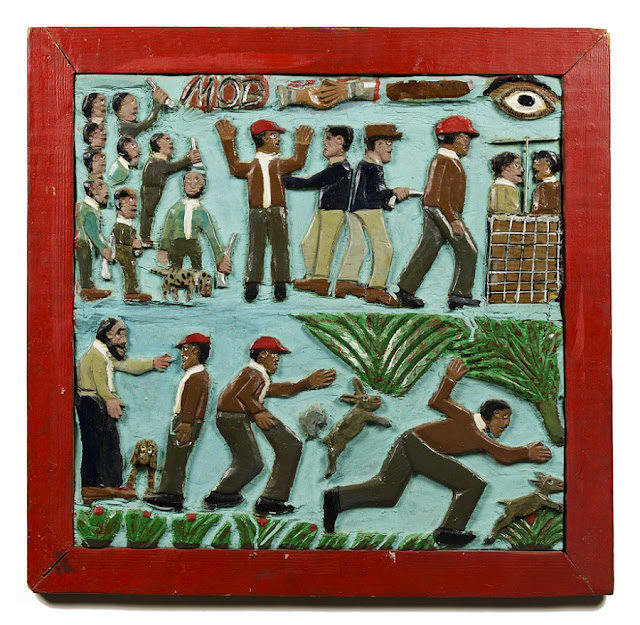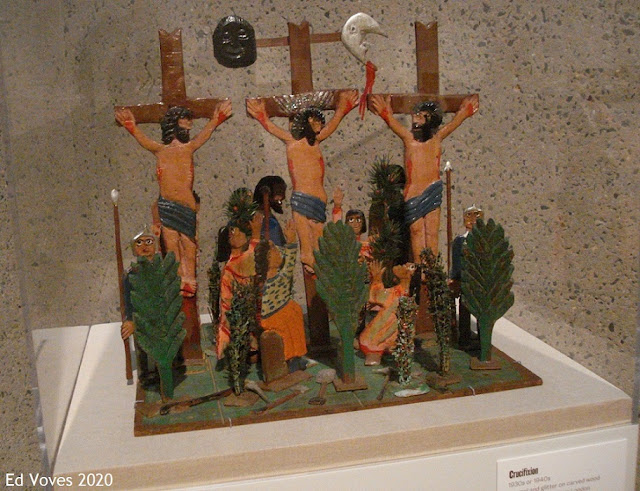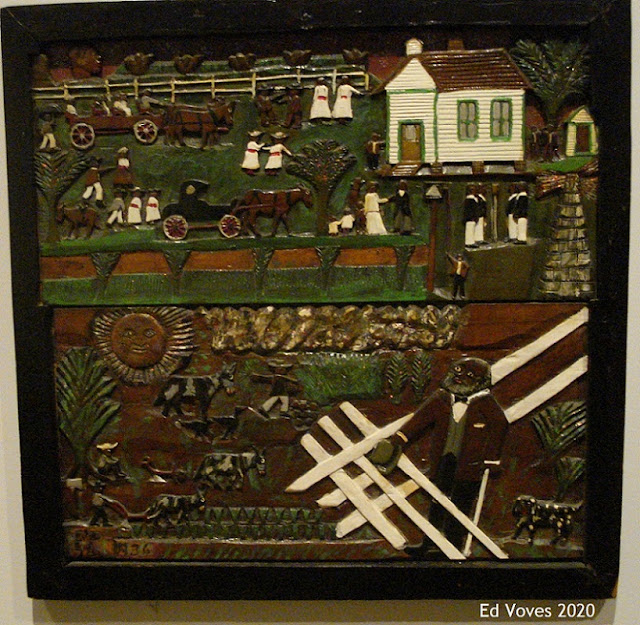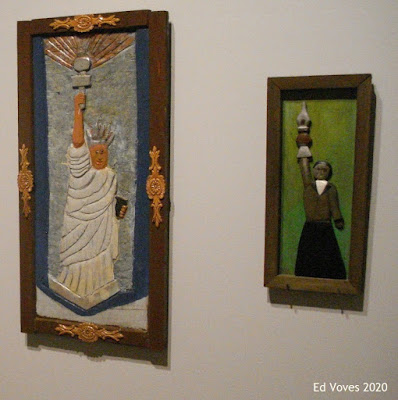Autumntide of the Middle Ages
Reviewed by Ed Voves
As World War I raged across Belgium and northern France, a Dutch historian named Johan Huizinga (1872-1945) worked on a book about the culture of these battle-scarred regions. Huizinga chose a distant era, the late Middle Ages, on which to focus.
What Huizinga wrote about Medieval Europe had a resonance for the events of 1914-1918. Now, in the troubled twenty-first century, the Dutch scholar's historical insights are equally timely.
Huizinga's great work, Autumn (or Autumntide) of the Middle Ages, was published a century ago in 1919. The Dutch word for autumn, Herfsttij, was chosen by Huizinga to reflect the way that the civilization of Medieval Europe had aged, atrophied and faded away.
This process was anything but a calm, gradual process. Europe during the 1300's-1400's was wracked by wars, plagues and revolts.
"So fierce and clamorous was life" during the late Middle Ages, Huizinga wrote in an immortal sentence, "that it could endure the mingled odor of blood and roses."
While these calamities wreaked havoc, poets, especially at the court of the Duchy of Burgundy, diverted the minds of the aristocratic ruling class with tales of Chivalry. Even more sensational were coy, erotic poems such as Romance of the Rose. Of course, this hugely popular poem was garbed with plenty of "look-but-don't touch" symbolism. But everyone understood the life and death truths of their troubled times - regardless of how these elaborate fictions tried to disguise reality.
To gain insight into the social milieu of his topic of study, Huizinga read widely in the literature of the 1300's-1400's. He also closely studied the masterpieces of art produced during that period.
It needs to be emphasized that Huizinga's "required reading" of his literary sources was an heroic endeavor. Almost all of the poets and secular writers in France, Burgundy and the Netherlands during the 1300's-1400's were definitely of the second-rank - none remotely matched Chaucer or Petrarch. Many of them, like Eustache Deschamps and George Chastelain, were scarcely remembered in Huizinga's time and are chiefly known today because he discussed them!
Autumntide of the Middle Ages is the definitive book on the late Medieval era. The Dutch university where Huizinga taught, the University of Leiden, has just published a new edition of this classic work, in collaboration with the University of Chicago Press. It is a huge, brilliant volume, brimming with high quality illustrations mentioned in the text and an insightful essay detailing Huizinga's career and the reception of his magnum opus all over the world.
Of special note, Autumntide has been newly translated into English by Diane Webb. Huizinga wrote in an occasionally idiosyncratic style, very readable, but with numerous sentence fragments. Webb succeeds to a superb degree in adhering very closely to his text while making it intelligible to contemporary, English-speaking readers. This is also true for the great mass of medieval poetry which Huizinga quoted, newly translated in a parallel text with the original, mostly French, verse.
With her impressive knowledge of Dutch language structure and the nuances of Huizinga's style, Webb has achieved wonders: a compelling version of a classic book which has stood the test of time, as will her translation.
The central event of the historical era, so brilliantly analyzed by Huizinga, was the pandemic known as the Bubonic Plague or Black Death which ravaged Eurasia and North Africa. Between 1347-1353, this dread disease killed between one-third to one-half of Europe's population.
The Black Death reappeared at periodic intervals thereafter, insuring that a state of terror remained simmering in the hearts and minds of everyone from low-born peasant to the noblest lord.
Huizinga wrote in great detail on the way that images, both in literature and the visual arts, insured that people were reminded that death was ever lurking, ready to snatch them away from the delights of life and love. The ghoulish, almost gleeful, depiction of cadavers and skeletons in close proximity to living, vital people was so widespread that one has to assume that such imagery satisfied a macabre need, perhaps survivor's guilt, among those who had lived through the Black Death.
In Autumntide, Huizinga indirectly addressed political and military events. He cautioned against trying to understand the late Middle Ages in terms of great battles or details of demographics and GDP.
"Civilization has just as much to do with dreams of beauty and illusions of the noble life," Huizinga wrote, "as it does with population and taxation figures."
The medieval "dream of beauty" was an understandable, in some ways commendable, response to life's hardships. Yet, its "illusions" concealed hidden dangers if taken to extremes. And that is exactly what transpired. In another, celebrated passage, Huizinga wrote:
The later Middle Ages is one of those end periods in which the cultural life of the higher circles has become almost entirely a parlour game. Real life is violent, hard and cruel; one reduces it to the beautiful dream of the chivalric ideal and builds on this the game of life. It is acted out behind the mask of Lancelot: it is a colossal self-deception.
It was because reality was so terrible that these rarefied forms of poetry, art and courtly manners should have been appreciated as a "parlour game." Reading between the lines, Huizinga astutely surmised that many of the more level-headed knew the "score." They played the "game" and then got on with life. Such realists understood that a jousting tournament between armored knights was not "real" warfare.
Yet it was hard to keep a sense of balance because the emotional climate of late Medieval Europe was one of extremes. Hysterical reaction to adversity was contrasted with manic or outlandish celebrations. Almost unbearable sensitivity alternated with unrestrained cruelty.
The Europe-wide embrace of these "dreams of beauty and illusions of the noble life" was centered upon the Duchy of Burgundy. Located to the east of Paris on some of the most fertile lands of Western Europe, Burgundy was the heartland of Europe, both figuratively and politically.
With the central control of the French monarchy weakened by war with England, the dukes of Burgundy sensed an opportunity to create a powerful realm of their own. Possessed of great wealth produced by the cities of Flanders under their control, the lords of Burgundy nearly succeeded.
Huizinga presumed that the readership of Autumntide would be familiar with the basic historical details of Medieval France and so did not provide a sustained narrative of Burgundy's rise and fall. However, English-speaking readers have often been at a disadvantage in respect to the chronology of French history. A brief summary might therefore be useful.
Burgundy's rise began when Philip the Bold received the Duchy of Burgundy from his father, King John of France, in 1361. Although he was John's youngest son, he proved the most capable. A skillful statesman, Philip transformed Burgundy into a powerful feudal state.
Philip died in 1404 and was succeeded by John the Fearless. As his nickname suggests, John was belligerent and ruthless, leading to his assassination in 1419. John's heir, Philip the Good, joined in an alliance with England against France, which made Burgundy even more of a power to be reckoned with. By the time Philip died in 1467, Burgundy was a de-facto kingdom of its own, stretching from its subject territories in present day Belgium and Holland down to central France.
Philip's son, Charles, was nicknamed the "Bold" as his ancestor had been, but his rash courage proved to be Burgundy's undoing.
Charles had delusions of grandeur exceeding what even the vast financial resources of Burgundy could support. He was also a major devotee of the code of Chivalry. In a reckless series of wars, Charles threatened the reviving power of the French monarchy and incurred the enmity of the Swiss Confederation, whose pike-wielding infantrymen joined an alliance against him. At the Battle of Nancy in 1477, Charles suffered a resounding defeat and was killed in hand-to-hand combat.
Like the depiction of the fiery fall of Lucifer and his rebel angels in the Très Riches Heures of the Duke of Berry, the arrogant Charles and his armored paladins crashed to earth.
Why did Burgundy not succeed? Charles the Bold had a well-trained army and the latest in gunpowder-firing cannons. His weakness was a psychological dependency on a way of thought that failed to conceptualize the real world as it actually was. In embracing Chivalry, Charles marched to war with modern weapons and outmoded ideas.
Of the debilitating effects of Chivalry, Huizinga wrote:
Were statecraft and warfare actually swayed to some extent by chivalric ideas? Undoubtedly, if not in their virtues, then at least in their flaws. Just as the tragic mistakes of the present have sprung from the delusion of nationalism and cultural pride, so too the failings of the Middle Ages sprang more than once from the chivalric idea.
The "autumn" of the Middle Ages about which Huizinga wrote was matched by the "autumn" of the Europe of his times. While writing Autumntide in Leiden, Huizinga could occasionally glimpse the distant flashes of artillery fire which reduced the medieval city of Ypres, in nearby Belgium, to rubble. The almost continuous series of battles, beginning in mid-October 1914 and lasting to October 2, 1918, provided Huizinga with a vivid reminder of human folly as he worked on the final drafts of Autumntide.
The Netherlands maintained neutrality, shielding it from the most devastating affects of the "Great" War I. Yet, the war's impact on Huizinga, a European scholar and astute political observer, was marked. Given the long lead-up to the conflict and the location of the main battle fronts in Belgium and northern France, it might seem natural for Huizinga to have chosen the passing of the Middle Ages as the focus of his research. Actually, Huizinga came somewhat late to the profession of history and then, only by an indirect path, to the study of the prideful, self-destructive Duchy of Burgundy.
The young Huizinga was a brilliant linguist. In addition to several European languages, he was fluent in Sanskrit, had a working knowledge of Hebrew and Arabic and had studied Buddhism in considerable detail. When he did begin teaching history, he did so in a wide-ranging manner, without specializing in a specific era. When it came time to publish a major work, he seemed destined to write a great treatise on Asian history rather than a subject closer to home.

Huizinga began thinking deeply on the paintings of van Eyck, van der Weyden and the others - which of course, were anything but primitif. Indeed, many scholars of Huizinga's day and later elevated these Flemish masters to the status of trend-setting innovators, equal in skill to the great Italian artists of the early Renaissance. This is still a valid conception, as can be seen in the notable book, The New Art of the Fifteenth Century by Shirley Neilsen, which I reviewed back in 2015.
Huizinga, however, came to a different conclusion.
In a moment of epiphany while taking his afternoon walk, Huizinga realized that van Eyck's paintings, despite their realism and the revolutionary implications of painting in oil, were medieval masterpieces. Van Eyck's Ghent Alterpiece and other works represented the consummation of the civilization of the Middle Ages rather than the opening act of the Renaissance.
Jan van Eyck, Giovanni Arnolfini and his Wife, 1434 (and detail)
We would like to think of Jan van Eyck as an early example of the Renaissance individualist. After all, his signature on the portrait, Giovanni Arnolfini and his Wife, is still clearly visible: Johannes de eyck fuit hic, 1434. Jan van Eyck was here. In painting a work for a patron like Arnolfini, an Italian merchant and a personal friend, van Eyck could make his personal mark. But painting for his noble master, the Duke of Burgundy, was an entirely different matter.
When van Eyck served the Duke or a high-ranking Church official, he did so in the capacity of a servant. He was a highly regarded and well-paid one to be sure, but still a servant. He and contemporaries like Rogier van der Weyden and Hans Memling were tasked to emphasize splendor rather than beauty in works for noble patrons. For the Church, a complex code of symbolism ruled what could be painted.
Hans Memling, The Annunciation, c. 1465-70
As Huizinga astutely realized, the Flemish painters' astonishing mastery of the material details of their subjects - the texture of brocade cloth, the shimmer of silk, the polished surface of an armor breastplate - reflected the hierarchical code of the Middle Ages.In a passage toward the end of the book, Huizinga pronounced that "Art from the end of the Middle Ages faithfully reflects the spirit of the end of the Middle Ages, a spirit that had reached the end of its path."
That might seem so evident as to be beside the point. In fact, it is a key insight.
The forms of life - technology, finance, social relationships - during the 1300's-1400's were undergoing rapid, revolutionary, change. The printing press, double-entry accounting, linear perspective in art... the list of major innovations of the era is impressive. Yet, like Charles the Bold with his state-of-the-art artillery and medieval tactics at the Battle of Nancy, Europe's power elite could neither comprehend nor control the vast changes taking place.
Huizinga concluded that the next historical epoch began, not with a dramatic event or sequence of events, but rather with a mood change, a mental re-orientation. "The Renaissance comes only," he wrote, "when the tone of life turns..."
It took quite a while for leaders all over Europe to come to grips with this change in the "tone of life."
Ironically, Huizinga himself grappled with a variation of this problem - how to describe it in the title of his book.
As he neared the publication date, Huizinga struggled on what to call his book. As Graham Small notes in his excellent essay on Huizinga, the perplexed author kept choosing and rejecting titles before finally selecting Herfsttij der Middeleeuwen or Autumn of the Middle Ages. It was just the beginning of long, eventful publication career for Huizinga's classic work.
Huizinga's "big book on Burgundy" was finally published in early 1919, during the uneasy interim between the Armistice of November 1918 and the signing of the Versailles Peace Treaty on June 28, 1919. Herfsttij was translated and published in England in 1924, in what is regarded as a very accomplished, though abridged, translation. The title was changed to The Waning of the Middle Ages.
"Waning" is an odd, somewhat unsettling word, as if civilizations go through phases like the moon. The French translation used the more comprehensible "Decline" to express what happened to medieval society during its last century. But perhaps most bizarrely, the French waited until 1932 to publish Le Déclin du Moyen Age, even though its main focus was on Burgundy, the French speaking communities of Belgium and the overarching society and culture of France itself.
Huizinga kept working on further editions of Herfsttij/Autumntide until the one published in 1941. By then, Nazi Germany had invaded the Netherlands. Huizinga published articles critical of the Third Reich, even as the Wehrmacht's jackbooted troops occupied Holland. Huizinga was arrested in 1942 and ousted from his professorship at Leiden University. Placed under virtual house arrest, he died on February 1, 1945, during the "hunger winter" which preceded the Allied liberation.
***
Text: Copyright of Ed Voves, all rights reserved
Introductory Image: Cover Art of Autumntide of the Middle Ages, courtesy of the University of Leiden © University of Leiden
The Garden of Love, from the Romance of the Rose, c. 1490-1500. Manuscript. British Library. Harley MSS. 4425 https://www.bl.uk/collection-items/roman-de-la-rose
Title page of Autumntide of the Middle Ages, by Johan Huizinga, published by the University of Leiden, 2020
Jean Le Noir ((French, active 1331–75-attributed to) The Three Living and the Three Dead, from the Psalter of Bonne of Luxembourg, before 1349.Tempera, grisaille, ink, and gold on vellum: individual folios: 4 15/16 x 3 9/16 in. (12.6 x 9 cm). Metropolitan Museum of Art, The Cloisters Collection, 1969. #69.86
Ivory Plaque with Tournement Scene, c. 1320-1340. Ivory: 3 7/8 x 6 15/16 x 1/4 in. (9.8 x 17.6 x 0.7 cm) Metropolitan Museum of Art.Gift of J. Pierpont Morgan, 1917. # 17.190.256
Philippe le Bon and Charles le Téméraire, extract from the Collection of Arras (ms. 266), work attributed to Jacques Le Boucq, 16th century, Arras, municipal media library. © Arras Media Library
Limbourg Brothers (French, 1400-1416) The Fall of Lucifer, in the Très Riches Heures du Duc de Berry, Folio 64 verso. Illuminated manuscript. Musee Conde.
Poster for the Les Primitif Flamands Exhibition, 1902. Bruges collections, Musea Brugge. https://commons.wikimedia.org/wiki/File:Les_Primitifs_Flamands_poster.jpg
Jan van Eyck (Flemish, active 1422; died 1441) Giovanni Arnolfini and his Wife, 1434. Oil on oak: 82.2 x 60 cm. National Gallery of Art, London. Purchased, 1842, # NG42
Hans Memling (Netherlandish, active by 1465–died 1494) The Annunciation, c. 1465–70. Oil on wood: 73 1/4 x 45 1/4 in. (186.1 x 114.9 cm) Metropolitan museum of Art. Gift of J. Pierpont Morgan, 1917 #17.190.7
Cover art for earlier U.S. editions of Autumntide of the Middle Ages










